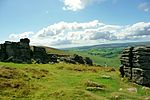Grimspound
Archaeological sites in DevonBronze Age sites in DevonDartmoorEnglish Heritage sites in DevonFormer populated places in Devon ... and 1 more
History of Devon

Grimspound is a late Bronze Age settlement, situated on Dartmoor in Devon, England. It consists of a set of 24 hut circles surrounded by a low stone wall. The name was first recorded by the Reverend Richard Polwhele in 1797; it was probably derived from the Anglo-Saxon god of war, Grim (more commonly known as Woden, or Odin). In 1893 an archaeological dig was carried out by the Dartmoor Exploration Committee, which recorded many details of Grimspound as well as, controversially, making a reconstruction of the site. The site was designate as a scheduled monument in 1928.
Excerpt from the Wikipedia article Grimspound (License: CC BY-SA 3.0, Authors, Images).Grimspound
B3212, Teignbridge North Bovey
Geographical coordinates (GPS) Address Website External links Nearby Places Show on map
Geographical coordinates (GPS)
| Latitude | Longitude |
|---|---|
| N 50.61331 ° | E -3.83738 ° |
Address
Grimspound
B3212
TQ13 8RL Teignbridge, North Bovey
England, United Kingdom
Open on Google Maps







